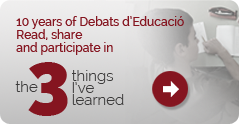- Català
- Español
- English
You are here
How to ensure that technological innovation improves academic performance? The case of New York's iZone
About the speaker
Steven Hodas
Former executive director of the New York City Education Department's Office of Innovation
Síntesi d'idees
Background
In 2010, the New York City Education Department set up iZone, a project aimed at providing support to publicly funded schools in the use of innovation and technology to solve the principal learning problems, aiming for personalized solutions.
In 2012, Steven Hodas joined the project as executive director of the Innovation Office at the New York City Education Department. He was responsible for enriching the programme by developing a powerful strategy to weave ties between the schools and the market of technology developers working to provide innovation in education.
iZone is geared towards better meeting the needs, motivations and virtues of each individual child, and not simply students in general. The aim is not to find a one-size-fits-all solution for all schools, but to work with the community to determine the best ideas, technology and tools for each individual student, teacher and school, and to do it quickly.
Based on this model, user schools can design personalized learning for every student, access a wide variety of resources and head towards greater collaboration between students, teachers and families.
What is the iZone methodology?
- The problems are defined directly by those involved: teachers, students, families, etc. According to Hodas, “if the solution must be simple, we need to speak to the people for whom the solution must be simple”.
- The companies/start-ups responsible for developing the prototypes to solve the problems were given the freedom to address the problems in the manner they considered appropriate. Consequently, the companies had to use their know-how and creativity to propose the most appropriate tools.
- They work in a collaborative and cooperative manner. The education community works directly with the developers (the developers enter the classrooms). This generates trust, given that the education community will more readily accept solutions they have been directly involved in. This is a break from the sense of exclusion caused by solutions/products that are imposed from the outside.
- The projects have to be implemented rapidly in order to solve the problems of the moment. There is no need to wait to be absolutely certain that it will work. According to Hodas, “quick and crude is better than slow and refined. We do not need to seek perfection, but to question the things that did not work in the past”.
- We are playing down the importance of errors. We need to be willing to make mistakes. If the solution does not work, we discard it and try to find another one.
What are the success factors of the iZone model?
- We are working to come up with personalized solutions adapted to the problems of each school and its students at a given moment.
- The actions are fast because they use a quick method of evaluation to determine the efficiency of the products in responding to the needs.
- The schools and companies that work in iZone gain prestige because they achieve major solutions. Approximately 300 schools belong to iZones; it is a large and solid community which has served as an example for others.
- It stimulates the development of the technology market applied to education (entrepreneurs, investors and innovators) and ensures a rich and relevant offer of tools and solutions for educators.
What barriers might we find to developing strategies of this type?
- Traditionally, schools are not innovation centres. They are structured to implement education policies that are imposed upon them. In addition, teachers are often not enthusiastic about change. On the other hand, many parents behave in a conservative way because they do not like their children to be experimented on.
- Generating the habit of applying technological innovation by collaborating directly with the developers requires time and leadership. Otherwise, the changes will not be sustainable and scalable and a possible change of education policy will signal the end of the projects.
How can we connect the education community with the technology market?
For the developers, being able to enter the classrooms and discover at first hand the users of the programmes they have to design and implement is a great opportunity.
As for the teaching staff, the iZone has demonstrated that it is an incentive for them too and it helps them create a community to share queries, problems and potential solutions.
Furthermore, the tools developed by iZone have improved the day-to-day work of the teachers.
Is it possible to replicate this model? Might we find obstacles depending on the different cultural and social contexts?
For Steven Hodas, the iZone is a model that can be applied to any situation because it always works to meet the needs of a specific school. He believes that courageous leadership and the involvement of the entire community is key.
Finally, Hodas points out that it is a method which minimizes risk because it seeks quick solutions and is applied to specific areas. To evaluate the results, he suggests that all that is required is common sense: “If the teachers enjoy it, the children want to be in the classroom and the parents are happy, then the initiative is a success”.
With the collaboration:
Discover
other ideas
-

The spiral of inquiry: a tool for educational tran...
Judy Halbert and Linda Kaser
2017 -

Building a school for the digital natives generati...
Kirsti Lonka
2017 -

Cities as connected learning networks - The Pittsb...
Sunanna Chand
2017







 The texts published on this website are, unless otherwise indicated, covered by the Creative Commons Spain Attribution - Non Commercial - No Derivs 3.0 licence. You may copy, distribute and transmit the work, provided you attribute it (authorship, journal name, publisher) in the manner specified by the author(s) or licensor(s). You may not use the material for commercial purposes. You may not transmit any derivative work from this material. The full text of the licence can be consulted here:
The texts published on this website are, unless otherwise indicated, covered by the Creative Commons Spain Attribution - Non Commercial - No Derivs 3.0 licence. You may copy, distribute and transmit the work, provided you attribute it (authorship, journal name, publisher) in the manner specified by the author(s) or licensor(s). You may not use the material for commercial purposes. You may not transmit any derivative work from this material. The full text of the licence can be consulted here: